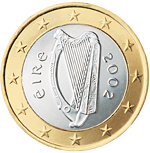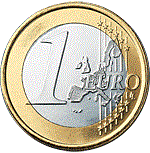
There are eight euro coin denominations, ranging from one cent to two euros. The coins first came into use in 2002. They have a common reverse, portraying a map of Europe, but each country in the eurozone has its own design on the obverse, which means that each coin has a variety of different designs in circulation at once. Four European microstates that are not members of the European Union use the euro as their currency and also have the right to mint coins with their own designs on the obverse side.
German euro coins have three separate designs for the three series of coins. The 1-cent, 2-cent and 5-cent coins were designed by Rolf Lederbogen, the design for the 10-cent, 20-cent and 50-cent coins were designed by Reinhard Heinsdorff and the 1- and 2-euro coins were done by Heinz Hoyer and Sneschana Russewa-Hoyer. Featured in all designs are the 12 stars of the EU and the year of minting.
Greek euro coins feature a unique design for each of the eight coins. They were all designed by Georgios Stamatopoulos with the minor coins depicting Greek ships, the middle ones portraying famous Greeks and the two large denominations showing images of Greek history and mythology. All designs feature the 12 stars of the EU, the year of imprint and a tiny symbol of the Bank of Greece. Uniquely, the value of the coins is expressed on the national side in the Greek alphabet, as well as being on the common side in the Roman alphabet. The euro cent is known as the lepto in Greek, a name which has also been used for the 1⁄100 denominations of the preceding currencies of the Greek state, the phoenix and drachma.
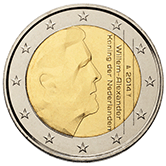
Dutch euro coins currently use two designs by Erwin Olaf, both of which feature a portrait of King Willem-Alexander of the Netherlands. The new designs began circulating in 2014. Dutch Euro coins minted from 1999 to 2013 feature a portrait of Queen Beatrix designed by Bruno Ninaber van Eyben. All coins share the 12 stars of the EU and the year of imprint in their design.
Finnish euro coins feature three designs. Heikki Häiväoja provided the design for the 1 cent – 50 cent coins, Pertti Mäkinen provided the design for the 1 euro coin, and Raimo Heino provided the design for the 2 euro coin, which shows cloudberry, the golden berry of northern Finland. All designs feature the 12 stars of the EU and the year of imprint.
Austrian euro coins have a unique design for each denomination, with a common theme for each of the three series of coins. The minor coins feature Austrian flowers, the middle coins examples of architecture from Austria's capital, Vienna, and the two major coins famous Austrians. All designs are by the hand of Josef Kaiser and also include the 12 stars of the EU, Flag of Austria and the year of imprint.
Italian euro coins have a design unique to each denomination, though there is a common theme of famous Italian works of art throughout history. Each coin is designed by a different designer, from the 1 cent to the 2 euro coin they are: Eugenio Driutti, Luciana De Simoni, Ettore Lorenzo Frapiccini, Claudia Momoni, Maria Angela Cassol, Roberto Mauri, Laura Cretara and Maria Carmela Colaneri. All designs feature the 12 stars of the EU, the year of imprint, the overlapping letters "RI" for Repubblica Italiana and the letter R for Rome. There are no Italian euro coins dated earlier than 2002, even though they were certainly minted earlier, as they were first distributed to the public in December 2001.

The cent, the United States of America one-cent coin, often called the "penny", is a unit of currency equaling one one-hundredth of a United States of America dollar. It has been the lowest face-value physical unit of U.S. currency since the abolition of the half-cent in 1857. The first U.S. cent was produced in 1787, and the cent has been issued primarily as a copper or copper-plated coin throughout its history. Due to inflation, pennies have lost virtually all their purchasing power and are often viewed as an expensive burden to businesses, banks, government and the public in general.
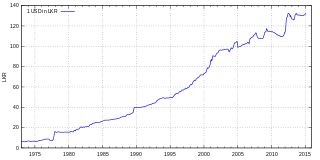
The Sri Lankan Rupee is the currency of Sri Lanka. It is subdivided into 100 cents (සත), but cents are rarely seen in circulation due to its low value. It is issued by the Central Bank of Sri Lanka. The abbreviation Re (singular) and Rs (plural) is generally used, the World Bank suggests SL Rs as a fully disambiguating abbreviation for distinction from other currencies named "rupee".

The lira or pound was the currency of Malta from 1972 until 31 December 2007. One lira was divided into 100 cents, each of 10 mils. After 1986 the lira was abbreviated as Lm, although the original £M sign continued to be used unofficially. In English the currency was still frequently called the pound even after its official English language name was changed to lira.
There have been three sets of coins in Ireland since independence. In all three, the coin showed a Celtic harp on the obverse. The pre-decimal coins of the Irish pound had realistic animals on the reverse; the decimal coins retained some of these but featured ornamental birds on the lower denominations; and the euro coins used the common design of the euro currencies. The pre-decimal and original decimal coins were of the same dimensions as the same-denomination British coins, as the Irish pound was in currency union with the British pound sterling. British coins were widely accepted in Ireland, and conversely to a lesser extent. In 1979 Ireland joined the Exchange Rate Mechanism and the Irish pound left parity with sterling; coin designs introduced after this differed between the two countries.

The San Francisco Mint is a branch of the United States Mint. Opened in 1854 to serve the gold mines of the California Gold Rush, in twenty years its operations exceeded the capacity of the first building. It moved into a new one in 1874, now known as the Old San Francisco Mint. In 1937 Mint operations moved into a third building, the current one, completed that year.
The coins of the Fijian dollar have been part of the physical form of Fiji's currency, the Fijian dollar.
The coins of Canada are produced by the Royal Canadian Mint and denominated in Canadian dollars ($) and the subunit of dollars, cents (¢). An effigy of the reigning monarch always appears on the obverse of all coins. There are standard images which appear on the reverse, but there are also commemorative and numismatic issues with different images on the reverse.
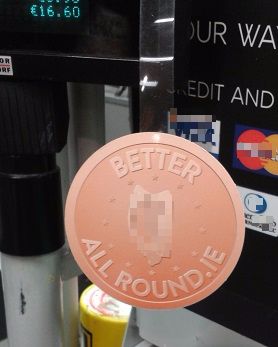
Cash rounding or Swedish rounding occurs when the minimum unit of account is smaller than the lowest physical denomination of currency. The amount payable for a cash transaction is rounded to the nearest multiple of the minimum currency unit available, whereas transactions paid in other ways are not rounded. Cash rounding typically occurs when low-denomination coins are removed from circulation owing to inflation. Cash rounding may be a compulsory legal requirement if such coins are no longer legal tender, or a voluntary practice where they remain in circulation but are scarce or impractical.

The 1 euro cent coin (€0.01) has a value of one hundredth of a euro and is composed of copper-covered steel. It is the lowest-value coin in the Eurozone; the next highest are the 2 and 5 euro cent coins. All euro coins have a common reverse and a country-specific (national) obverse. The coin has been used since 2002 and was not redesigned in 2007 as was the case with the higher-value coins.
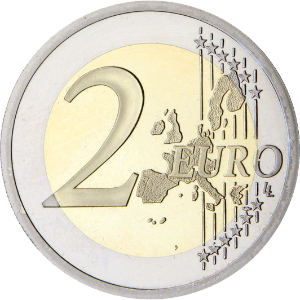
The 2 euro coin (€2) is the highest-value euro coin and has been used since the introduction of the euro in 2002. The coin is used in 22 countries with a collective population of about 341 million. The coin is made of two alloys: the inner part of nickel brass, the outer part of copper-nickel. All coins have a common reverse side and country-specific national sides. The coin has been used since 2002, with the present common side design dating from 2007.
The coins of the Australian dollar were introduced on 14 February 1966, although they did not at that time include the one-dollar or two-dollar coins. The dollar was equivalent in value to 10 shillings in the former currency.
The coins of the New Zealand dollar are used for the smallest physical currency available in New Zealand. The current denominations are ten cents, twenty cents, fifty cents, one dollar and two dollars. The $1 and $2 coins are minted in a gold colour, the 20c and 50c coins are silver colour and the 10c coin is plated in copper.

This article covers euro gold and silver commemorative coins issued by the Central Bank and Financial Services Authority of Ireland. It also covers rare cases of collectors coins minted using other precious metals. It does not cover either the Irish €2 commemorative coins or the Irish Pound commemorative coins.
